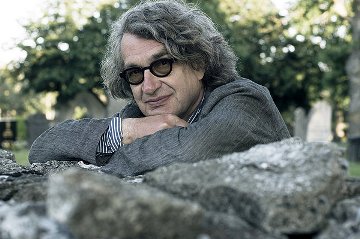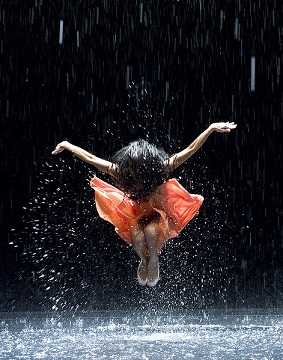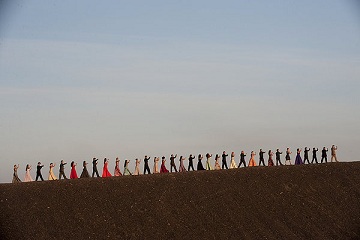
In 1985, German director Wim Wenders was prodded by his girlfriend to watch a performance of choreographer Pina Bausch's eerie Café Müller. As he recalls it now, he dreaded the evening that awaited, not knowing that what he was about to witness would change his movies and his life.
Twenty-seven years later, the 66-year-old Wenders has earned his second Oscar nomination for helming Pina, a 3D documentary tribute to Bausch that features her company Tanztheater Wuppertal Pina Bausch performing some of her best known pieces.

While Wenders had become her friend and admirer, Bausch sadly was unable to see the final film or even participate in the shooting because she died unexpectedly in 2009 at the age of 68. Nonetheless, she's helped Wenders, whose other films include classics like The American Friend, Paris, Texas and Wings of Desire, gain some of the best reviews of his career.
Speaking by phone from Los Angeles, Wenders started our conversation, wondering about my Anglicized surname (after hearing it pronounced, he correctly guessed that it was German). When I told him Buena Vista Social Club brought me and my beloved together, he replied, "I take full responsibility."
When it comes to Pina, however, he clearly assigns her the proper credit and acknowledges that she's still with him, like an angel in Wings of Desire.
Despite making so many movies, this is only your second Oscar nomination. Your first was for Buena Vista Social Club. Why do you think you've gotten both of them for your documentaries instead of your fiction films?
(Laughs) That's a great question. I don't know. I really don't know.
Maybe my fiction films have never been really successful in America. I think the most successful of my fictional films was Wings of Desire. Maybe it's because they weren't seen by a huge audience, but Wings of Desire was seen by a lot of people. So I don't know. I just never got up there. I never made either the German entry for Best Foreign Film, or when I shot in English -- I shot a lot of films in English -- I never made it up there.
Actually, I never thought about this. This is a strange question. It's funny, and I'm also a member of the Academy but of the documentary branch. They've embraced me as a documentary filmmaker, which is totally fine with me because as I'm getting older, I'm more and more driven to reality-driven movies. I love documentaries more and more, and as you might have noticed, they take up more and more space in my life.
Didn't it take you about two years to do the actual filming of Pina?
Yes. We started prepping this film and thinking about it, Pina and I, in 2007. We started shooting in the fall of 2009. We edited it for a year and a half. This film took a long time, yes.

Because of the length of time it took you to make Pina, you said that the 3D technology improved as you were making the film. How did it improve?
Oh, man. It improved at lightning speed. When we started shooting, equipment and the 3D rigs were very clumsy and big. The first leg of the shoot was all the stage performances.
We shot for about a month. The cameras were always on a big monster of a dinosaur, a big dinosaur crane called a Techocrane. We had a big, big crane because it was such heavy equipment. And you could only put it on a crane or tracks because you couldn't possibly think of shooting on a Steadicam. That didn't exist yet.
It was all too heavy, and my stereographer (Alain Derobe), he realized how much I wanted to be lighter and move differently. So he developed the very first Steadicam rig for me, and with the second leg of the shoot, not only was the crew much smaller -- we had started with a crew of 50 people. And the camera department alone was five or six. And then in the second leg of the shoot when we shot outdoors, technology had made it possible so that we could shoot out of doors and that we could have a lighter unit. We were down to 20 all of the sudden.
And during the very last part of the shoot, we were five or six people. We were always working with prototypes, but the prototypes had gotten from very, very heavy to very, very light in one year.
Wow.
And, well, again this is two years later. We could shoot it again, very differently today.
What was it about Bausch's choreography that turned you from a skeptic into a fan?
It was the fact that it concerned me.
Dance, I never felt could possibly concern me. I was never really into dance, and I thought it was an aesthetic experience that I had no antennae for. And then when I saw Pina's pieces for the first time, I was just... touched. When I saw the first piece, I found myself crying for 40 minutes. That was as long as it lasted.
And I didn't know what had happened because it hit me like lightning. It was a revelation. It was like I was watching a whole different language that had nothing to do with the dance that I had seen so far with classical ballet or modern dance. This was a very human, very emotional expression that I felt everybody should have access to, especially everybody like me who thought they weren't into dance.
So you've made this film for people, who like you, would have initially been turned off by the subject.
Absolutely. That's my target group right there, people who say, "Oh, dancing, include me out." That's who I really made this film for because Pina really turned me into somebody who's really happy that she opened this whole page in my life. She opened a whole different access to life for me.
How did you decide to approach this film once you no longer had her direct involvement?
Well, we'd been talking about it together for more than 20 years. We had been very much involved with the concept, and Pina had chosen the pieces for the film. And finally, we had found the right technology in 3D. And I was finally ready to do it.
We prepared film together actively for the last two years. And then tragically, just shortly before we were ready to shoot, she passed away. And that was so disappointing for me. If you talk about something for more than 20 years -- and to do it together, and if you really wanted to do this together, and that was the whole purpose of it, it was just unimaginable that Pina would die when she did. And I walked away from the film because I was too disappointed and too shocked.
And there would never bee a movie if it wasn't for the dancers because they didn't walk away. Even the night that Pina died, they went on stage in tears. But they went on stage because they figured that's what Pina would have expected.
And a few weeks later, they decided to continue the company as such without Pina and to fulfill all the obligations for the next three years for tours and performing. So that's why they then, a couple of months later, started to rehearse the pieces that Pina had put on the agenda, so we could film them.
That's when they got back to me and said, "It's a crying shame that we're doing this now, maybe for the very last time, and we remember how much Pina was very much looking forward and how much she was expecting from that new technology and how much you were so excited about shooting her work in 3D. Now, we can still make the film then. Maybe we can't make the film with Pina any more, but maybe can do the film for Pina together."

And it slowly dawned on me that that was very, very important, not just as an homage to Pina, but for these people who stood in front of that loss and didn't know how to deal with it. None of these dancers had been able to say goodbye, and me, too, as a friend. I hadn't been able to say goodbye or thank you to Pina.
So I realized the film needed to be a very different film, but there was a great purpose for it, and that's why we jumped back into it.
One thing that hit me during the testimonials is that these people were incredibly loyal to her, and even the children of the dancers were performing for her. What do you think inspired this loyalty?
Pina loved them very much, and she brought out something in each and every one of them that they all realized they would not have found without Pina. Pina had this uncanny ability to get to the core of a person and to find out the best in somebody. Some of them had done their entire professional life with Pina, up to 30 years or more. Pina was the center of their lives.
Pina's art is very special, and there is no other company that works like this, with her complete integration of everybody. She wasn't imposing her choreographies on anybody. She was developing it with the dancers, with a very unique method.
She'd ask them questions: simple questions, emotional questions, existential questions. And they would answer, but they were not allowed to answer with words. They were only allowed to answer with their bodies, with movement and dance. And Pina would look at their answers and talk about it and ask them to be more precise and be more personal and not with such of a cliché. She was start working on these answers and pushing her dancers to be more and more themselves and more honest, and drop all role playing and really give the most honest answer with their body. And that's how she developed her pieces, and no other choreographer, I think, ever worked like this. So these people are very, very loyal to Pina because they were her orchestra.
A lot of the things you do in Pina seem as if it would be impossible to do on stage, would that be a fair assessment?
Yeah. A lot of all the scenes were shot outdoors. Well, you could dance them on stage, but it would be a very different impression. We shot in traffic, in the city and in the subways, in the industrial wastelands and in nature. That, of course, added a lot to what the dancers showed me about Pina.
But you even have one scene where all the dancers turn from young to old in the blink of an eye. That couldn't be done on stage could it?
Well, that was done on stage.
No kidding?
Because that was a very unique piece in the history of dance that I think had never been done before. This was a piece that Pina called Kontakthof. She first did it in the late 70s with her ensemble. And then in the mid-90s, she did it with the same choreography, the same piece, with an ensemble of senior citizens. And then a few years ago, she did it with teenagers from 14 to 18. The senior citizens as well as the teenagers were dance illiterates, so it was the same piece done with different generations.
I filmed the elderly people as well as the teenagers, as well, of course, as Pina's own ensemble. It was pretty striking to have the same piece in front of you and to be able with one cut go from 16 years to 80 year
s in the same choreography, in the same story and the same piece.
One of my favorite pieces is the one where it looks like the girl is flexing her muscles, but it turns out her "arms" are actually those of her male partner hiding behind her. Was that tough to set up the photography?
Well, it worked on stage, and on film it even worked a little better because on stage people who were sitting on the side would see the trick, whereas on film we could do it more precisely. It was almost more beautiful to shoot it in 3D than to watch it on stage because it could really work perfectly. They were perfectly aligned, and it really felt like she was a very, very strong woman, and all the sudden you saw the trick, and it was very playful.
While you've captured her approach, your own fingerprints are all over it. When I saw the dancers' testimonials, I immediately thought of Wings of Desire where you'd hear a person's thoughts but their faces were immobile. Would that be a fair statement?
Wings of Desire has a very special connection with Pina because when I first encountered Pina in 1985, I saw everything she had ever made, and we got very close. And the next film I made, which was only two years later was Wings of Desire. It is by far the most choreographed film I've made. I don't think I would have had the courage. I don't think I could have made this up film because it was an improvised film, made without a script. I don't think I could have made it without my encounter with Pina. That film was something that really also linked us together.
All photos © 2011 IFC. Used by permission.
Official Trailer for Pina.
